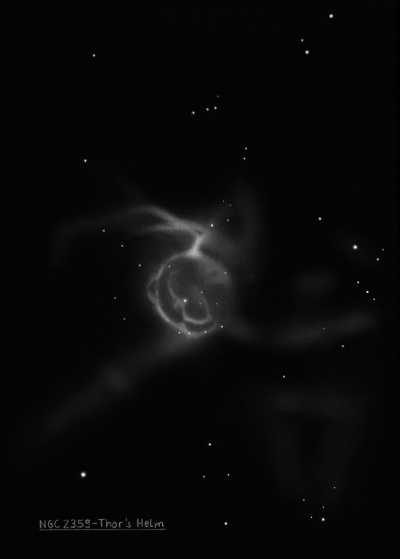
13x80mm (1/13/07): the circular central region of Thor's Helmet was easily visible at 13x in my 80mm finder using an OIII filter (24mm Panoptic), though the "horns" of the helmet were not seen.
William Herschel discovered NGC 2359 = H V-21 = h3075 on 31 Jan 1785 (sweep 363) and recorded "A broad elongated nebulosity, in the form of a parallelogram with a short ray southwards from the south preceding corner. The nebulosity between the milky and resolvable, almost of an equal brightness; but very faint. The parallelogram about 8' long and 5 or 6' broad, but ill-defined." He published a sketch in his 1811 paper (Fig. 3) as an illustration "of detached Nebulosity".
John Herschel observed this nebula from the Cape and recorded "a very singular nebula, much like the profile of a bust, (head, neck and shoulders,) or a silhouette portrait, very large, pretty well defined, light nearly uniform, about 12' diameter. In a crowded field of milky way stars, many of which are projected on it." His RA was exactly 1 minute too small (but accurate in NPD) and this position was copied into the GC and later the NGC. Howe noted this error when he observed the nebula. Herschel's sketch (Plate IV, figure 4) shows the silhouette shape well with the shoulders/bust region the brighter "wing". See notes for NGC 2361. From Malta, William Lassell sketched it similar to a balloon, with a long "neck" twisted in the southwest direction.
Joseph Turner made a more accurate sketch on 24 Jan 1876 with the Great Melbourne Telescope. The main 5' bubble is depected as annular with some interior nebulosity particularly south of the central star. The main tail was sketched accurately, though it ends before the thin streamer section. The prepared lithograph of the nebula was not published.
I'm surprised NGC 2359 is mentioned in Garrett Serviss' 1901 "Pleasures of the Telescope" written for at most 5-inch telescopes: "In [GC] 1511 we have a faint nebula remarkable for the rows of minute stars in and near it." And in the 1909 book "In Starland with a 3-inch Telescope", William Olcott repeats "Note the nebula [GC] 1511 and the curving row of faint stars near it."
Based on plate taken with the 60-inch at Mt Wilson in 1917, Pease reported: "Sir John Herschel pictured it as resembling a bust, while Lassell drew it like balloon, with a long neck twisted in the Sp direction. The balloon or head is approximately 5' in diameter; the neck is to the south, with nebulosity about 1' wide extending 8' west, concave on the north and gradually narrowing and fading out. From the top (N) of the head a symmetrical streamer concave to the south extends in the western direction...A second streamer about 1' wide extends east from the top of the head to a distance of 9'."
300/350mm - 13.1" (1/28/84): unusual emission nebula, fairly bright, fairly large, about 7'x5'. A thinner strip extends west of a mag 10.8 star on the south end. A few fainter stars are superimposed on the north side. A very faint section is also attached at the NW end extending towards the NW.
400/500mm - 17.5" (12/28/00): "Thor's Helmet" is a remarkably bright, detailed nebulosity at 100x using an OIII filter. The central region is a 5' bubble (illuminated by a Wolf-Rayet star) with a brighter rim along the west side giving a "C" appearance with irregular knots, filamentary wisps of nebulosity and areas of thinner nebulosity in the interior. A number of fainter stars are superimposed in the central region along with some brighter mag 11 stars on the north portion of the rim.
The southern "horn" of the helmet is attached at the south end of the bubble and a mag 10.5 star is attached to its SE side. The brightest portion is a thick 4' extension angling towards the WSW. As it extends more directly west it thins out into a long 10' streamer. The northern "horn" of Thor's Helmet" is attached at the northwest end of the central bubble and extends towards the northwest. This section is fairly long and thick but brighter along a thin spine. A fainter strip of nebulosity also begins on the northeast end of the central mass and extends 10' due east. Finally, weak nebulosity was also visible to the southeast of the central "helmet". Illuminated by the Wolf-Rayet star HD 56925 = WR 7.
900/1200mm - 48" (4/13/10): the 5' central region of Thor's Helmet was mesmerizing at 267x and 330x (unfiltered). A large, bright knot is at the south end of the rim where the inner portion of the bright wing that heads southwest connects with the central bubble. Along the northern edge of the rim are three collinear mag 11 stars (2.2' length) oriented E-W. The rim of the bubble is noticeably brighter in a thin arc beginning due north of center (between the two western stars) and extending about 90° clockwise to the west (this portion of Thor's Helmet was catalogued separately as NGC 2361). The rim is also brighter along a 45° thicker arc on the southeast side. The rim has a lower surface brightness on the east and NE side and varies in thickness and brightness around the entire bubble.
Three brighter stars (nearly collinear) and several fainter stars are superimposed within the main bubble. A second, smaller, incomplete bubble just north of center outlines an inner dark "hole", which includes one of the brighter stars. The 11.4-magnitude ionizing Wolf-Rayet star HD 56925 is at the southwest edge of this inner bubble. Additional thin wisps of nebulosity criss-cross the central region.
Notes by Steve Gottlieb